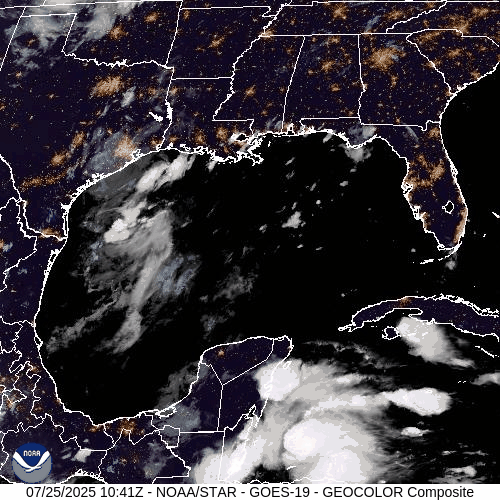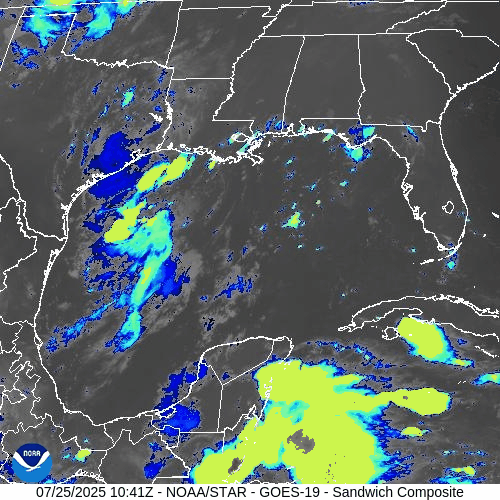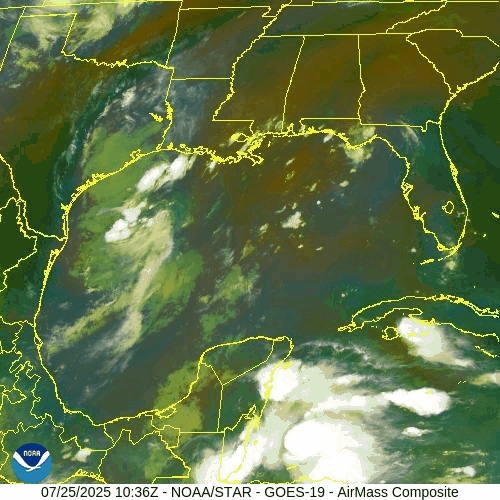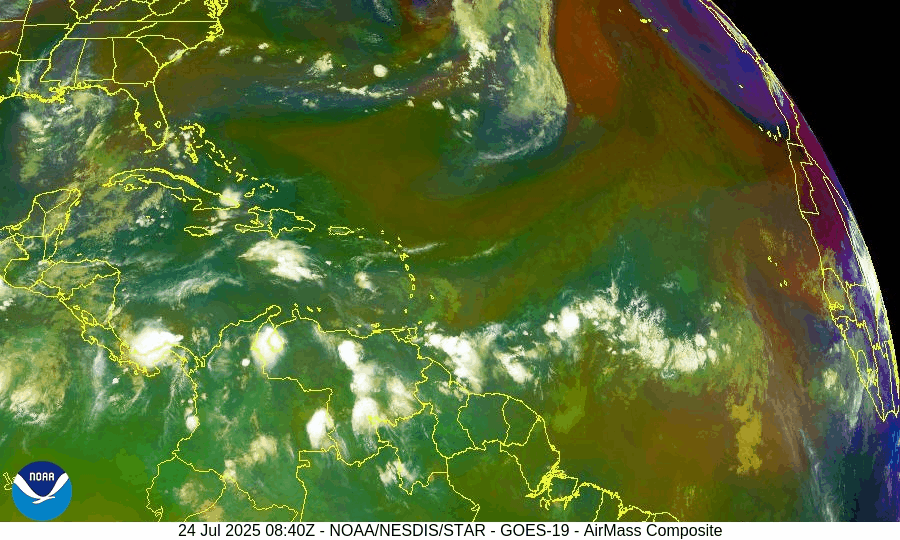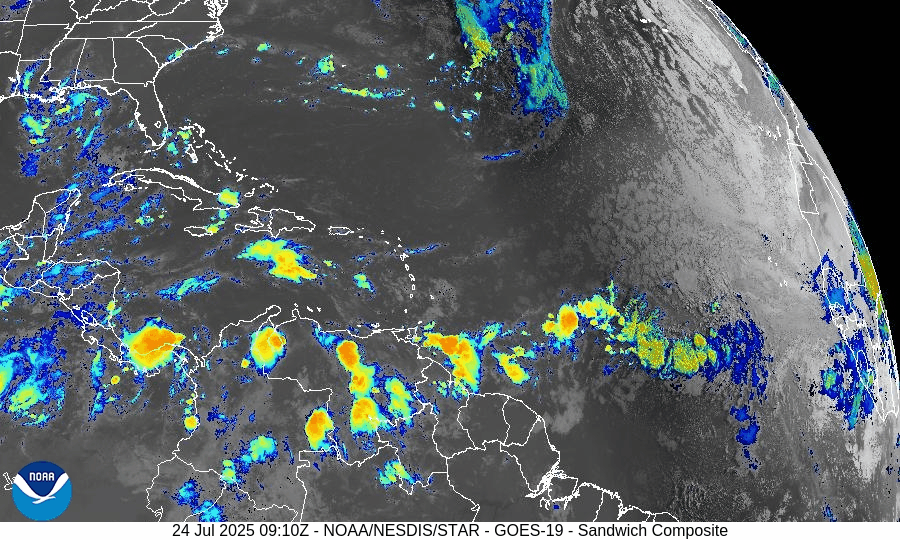Atlantic Hurricane Outlook – July 25, 2025: Gulf Disturbance Monitored, Basin Remains Broadly Quiet
Stay updated on the Atlantic hurricane season: July 25, 2025. A weak Gulf disturbance brings rain to Texas & Louisiana, while the broader Atlantic remains quiet with no immediate threats. Prepare now for August!
As we close out the final week of July, the Atlantic basin remains broadly quiet. The only area of interest remains a weak disturbance in the western Gulf of Mexico, which continues to produce showers but shows little sign of organizing. Elsewhere, several tropical waves are making their westward march across the Atlantic, but no significant development is expected in the short term.
Gulf of Mexico: Weak Trough Brings Rain, Low Development Risk
A surface trough remains draped across the western Gulf of Mexico, generating scattered showers and isolated thunderstorms—particularly offshore of Texas and Louisiana.
The disturbance remains disorganized, with no closed low-level circulation.
Wind shear and surrounding dry air continue to limit development potential.
The National Hurricane Center (NHC) gives this system a low (10%) chance of development over the next 7 days.
However, heavy downpours and localized flooding remain possible across parts of coastal Texas and southwestern Louisiana today.
This weak trough is expected to gradually dissipate as it moves slowly westward.
Atlantic Basin: Multiple Waves, No Immediate Threats
The broader Atlantic remains seasonally active with several tropical waves but no current threats:
Tropical wave near 50°W: Moving westward with scattered convection; not showing signs of organization.
New wave near 23°W, just off the coast of Africa: Tracking westward along the monsoon trough with convection near its southern flank.
A weak low embedded in the monsoon trough near 08N44W is helping spark convection but lacks any closed circulation.
None of these features show signs of imminent development, though they will be monitored closely in the coming days.
NOAA/NESDIS/STAR – GOES-19 Air Mass Composite – July 25, 2025
Sea Surface Temperatures & Atmospheric Conditions
Sea Surface Temperatures (SSTs) across the Gulf of Mexico and Main Development Region (MDR) remain well above average, supplying ample fuel for tropical development later this season.
Wind Shear remains moderate in the central and western Atlantic, limiting near-term organization.
The Saharan Air Layer (SAL) continues to suppress convection across much of the eastern Atlantic, especially north of the MDR.
Dust & SAL data from Windy.com
Florida Forecast: Typical Summer Pattern
Today’s outlook for Central Florida includes:
Highs in the low 90s°F (32–34°C)
Humidity: High, with heat indices nearing the upper 90s
Rain Chances: Scattered afternoon thunderstorms, driven by sea breeze and daytime heating
Winds: Light and variable, shifting southeast in the afternoon
No tropical impacts are expected for Florida at this time.
Radar imagery courtesy of Windy.com
Prep Tip of the Day: Review Your Evacuation Routes
Use this quiet period to refresh your storm plan:
Know your local evacuation zones
Map out primary and alternate routes
Keep a printed copy in your emergency kit in case power or cell service goes down
Share your plan with family or household members
Looking Ahead: Tropics Likely to Awaken in August
While the Atlantic basin remains quiet for now, the underlying signals—record SSTs, westward-moving waves, and easing shear—suggest a more favorable environment could emerge as we enter August. Stay alert, stay prepared, and keep checking in for daily updates.
Atlantic Hurricane Outlook – July 24, 2025: Gulf Disturbance Monitored as Tropics Remain Broadly Quiet
A weak disturbance in the Gulf of Mexico brings rain to the Gulf Coast, but tropical development chances remain low. Meanwhile, the broader Atlantic remains quiet.
As we near the close of July, the Atlantic remains largely stable, but the National Hurricane Center is monitoring a weak disturbance in the Gulf of Mexico for any signs of development. While conditions remain broadly unfavorable for rapid formation, subtle shifts in the atmosphere suggest we’re approaching a more active phase of the season.
Atlantic Basin: Broad Stability, But Eyes on the Gulf
As of the 8:00 AM EDT Tropical Weather Outlook, the National Hurricane Center (NHC) is reporting:
No active tropical cyclones
One disturbance in the Gulf of Mexico with low development chances
No tropical cyclone formation expected elsewhere over the next 7 days
NOAA/NESDIS/STAR – GOES-19 Air Mass Composite – July 24, 2025
Gulf of Mexico: Surface Trough Brings Rain, Low Development Risk
A broad surface trough located over the north-central Gulf of Mexico is generating scattered showers and thunderstorms. While upper-level winds remain hostile to development, the NHC notes this system could persist for several days as it drifts slowly westward.
Formation chance (7 days): Low (near 10%)
Main impacts: Localized heavy rain along portions of the Gulf Coast (especially Louisiana, Mississippi, and Alabama)
Conditions: Disorganized thunderstorm activity, no defined surface circulation
Expect periodic showers and thunderstorms over coastal waters and possible heavy rainfall inland through the weekend.
Rainfall forecast (ECMWF) courtesy of Windy.com
Caribbean Sea: Breezy Trades, Typical Mid-Summer Weather
No disturbances of concern
Fresh easterly trade winds dominate the central and southern basin
Scattered convection near the coasts of Central America (Panama, Nicaragua) due to the East Pacific Monsoon Trough
Seas remain moderate, with wave heights of 4 to 7 feet in open waters.
Wind forecast (ECMWF) courtesy of Windy.com
Wave height forecast (ECMWF Waves) courtesy of Windy.com
Atlantic Tropical Waves: Multiple Waves Marching West
GOES-19 - Sector view: Tropical Atlantic - Sandwich - July 24, 2025
Several tropical waves are present across the Atlantic:
Central Atlantic Wave (~35W): Slowly advancing west with scattered convection, no signs of organization yet.
New Wave Near 23W (Far East Atlantic): Recently introduced by the NHC; embedded within the monsoon trough, showing convective activity near its southern flank.
Low Near 08N44W: Part of the broader monsoon trough; helping to enhance scattered thunderstorms but remains disorganized.
These features will be monitored over the next 7–10 days as they move into warmer waters and potentially more favorable conditions.
850 hPa wind data courtesy of Windy.com
Saharan Air Layer (SAL): Dry Air Suppressing Growth
The Saharan dust plume continues to stretch across the central Atlantic, limiting tropical development by reducing moisture and increasing wind shear. However, long-range forecasts suggest the SAL may begin to thin as we move into August, potentially opening the door for more development.
Saharan Air Layer (SAL) dust data courtesy of Windy.com
Sea Surface Temperatures: Hot and Getting Hotter
Ocean temps across the basin remain above average:
Gulf of Mexico: 30–31°C (86–88°F)
Caribbean Sea: 29–30°C (84–86°F)
Main Development Region (MDR): 28–29°C (82–84°F)
These conditions are supportive of development—but only if wind shear and dry air ease.
Sea surface temperature data courtesy of Windy.com
Florida Forecast
Highs: 89–91°F
Rain Chance: 50–60%, mainly afternoon thunderstorms driven by seabreeze interaction
Winds: Light southeast winds
Hazards: Isolated downpours, brief gusty winds
Rain forecast data courtesy of Windy.com
Prep Tip of the Day: Review Your Local Evacuation Zone
During quiet days, take time to review your local evacuation maps and zones:
Know when you would leave and where you’d go.
Print hard copies in case cell service fails.
Share your plan with family and neighbors.
Find evacuation information from your county emergency management office or state disaster preparedness website.
Looking Ahead: A Turn Toward Activity?
While the current atmosphere is keeping storms at bay, sea temperatures and tropical wave activity suggest a transition toward increased potential in early August. The Gulf disturbance is not expected to develop significantly, but it reminds us that the quiet can shift quickly.
Stay informed and prepared—Cat5Prep.com will continue tracking it all, daily.



